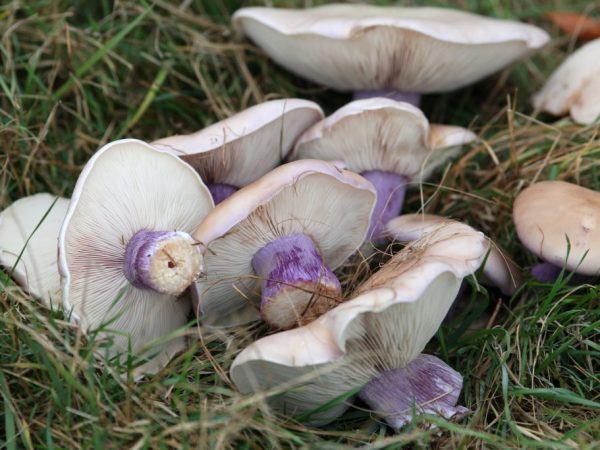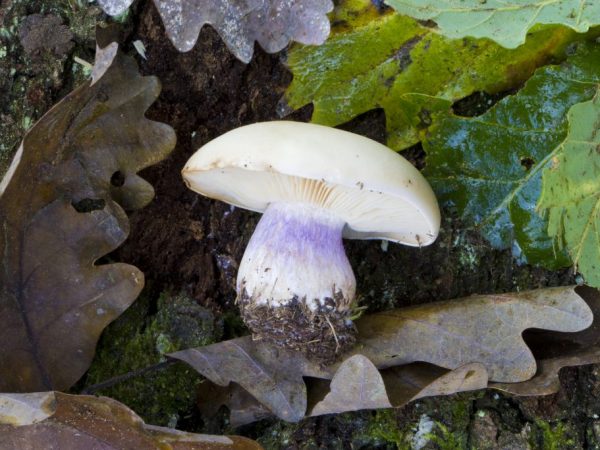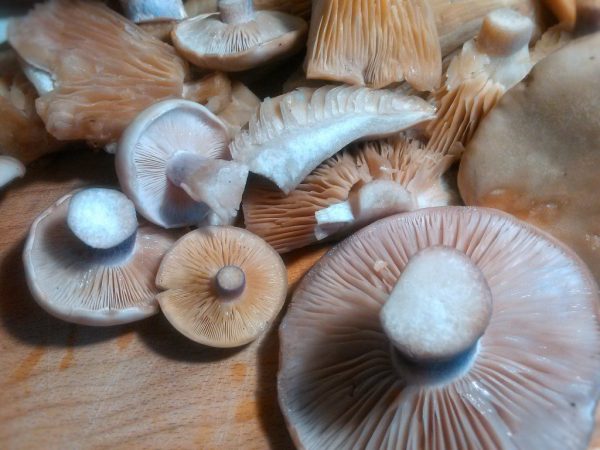What do bluefoot mushrooms look like?
One of the interesting natural representatives is the blue-legged mushroom, which in the scientific world is called the lilac-legged ryadovka for the characteristic color of its legs.

What do bluefoot mushrooms look like?
Description of appearance
A row of blue feet, or two-flowered, has an unusual appearance.
Popularly, the lilac-footed ryadovka has many names: blue root mushroom, lilac-footed ryadovka, lilac-footed ryadovka, blue-footed ryadovka, etc.
The bluefoot mushroom has the following description:
- hat: brownish-yellow with a purple tint, up to 16 cm in diameter, in young - convex, in older - flat-convex or cushion-shaped. The surface of the cap (skin) is smooth;
- hymenophore: lamellar, frequent. The plates are wide, yellow or cream colored;
- spores are elliptical;
- pulp: fleshy, thick, dense in young mushrooms, and loose in older ones. The color ranges from white to gray or even gray-brown. The pulp has a fruity aroma and a sweetish aftertaste;
- leg: lilac fibrous (this is outwardly well noticeable in young mushrooms), 3 cm in diameter and reaching a height of up to 10-12 cm. Young ones have remnants of a bedspread on the surface of the legs. As the mushroom matures, the surface of the stem gradually becomes smooth.

The mushroom has a lilac fibrous stem
The lilac-footed row is a little-known edible mushroom. The edges of her cap are bent inward, the surface is oily, similar to the surface of an oil can.
The stem is dense, with clear and bright purple-blue fibers.
The pulp is pleasant to the touch, with a bluish tint, a pleasant characteristic aroma. The taste is reminiscent of champignons.
The lilac-footed mushroom has grayish plates with a pink or brownish tint. Fastened freely or notched. Spore powder yellow-pink.
Better to harvest younger fruiting bodies. The younger they are, the whiter.
Irina Selyutina (Biologist):
For its growth, the lilac-footed rower prefers alkaline soils of meadows, forest glades, or in areas of already abandoned farmland or on pastures. This mushroom grows in rather large colonies - "witch circles". The peak growth of fruiting bodies occurs in September, although they can be harvested from August to November. Experienced mushroom pickers go to the forest to "hunt" for these mushrooms only in dry weather - after the rains they are sticky and slippery.
These mushrooms are able to grow even at low temperatures and are found in forests during light frosts, when the temperature drops to -5 ℃. That is why you can collect them until November inclusive.
Similar types and their differences
The bluefoot row grows well in temperate climates and in cool areas, under fir or Christmas trees. In the deciduous forests of Crimea, mushrooms find their place under beech, birch or oak. They grow from mid-August to the very frost.
The blue leg is confused with the following rows:
- R. purple;
- R. dirty;
- R. yellow;
- R. terracotta;
- R. pale.
All of them are similar to the original, but - whatever one may say, differences in color are noticeable. For example, the purple ryadovka is completely purple (which corresponds to the species name), and the edible purple has only a leg of that color.
The row is dirty, or weedy (Lepista sordida), has a lilac skin, but is much smaller in size. It grows in more wetlands.
False bruise is a conditionally edible species. Poisoning will not occur if a non-original is accidentally dropped into the basket.
Beneficial features
Edible blue feet have a rich vitamin composition, a huge amount of minerals and trace elements necessary for the human body. One serving of mushrooms contains enough copper, manganese, zinc, potassium, phosphorus, iron and sodium to fill the deficit in the daily requirement.
Their regular use in food contributes to the normal functioning of the body as a whole. They contain high quality protein and amino acids.
They contain 18 amino acids. There is no such quantity in any representative of the plant kingdom. Alanine, threonine, lysine, stearic and glutamic acids predominate.
The sugar substance trehalazole gives the pulp a pleasant sweetish taste.
Natural antibiotics, clitocin and fomecin, make the ryadovki unique. It is these substances that have a deadly effect on cancer cells and pathogenic bacteria.
The "blue leg" contains 10 types of polysaccharides.

Blue feet have a large composition of vitamins
Harm and contraindications
Along with the benefits, the purple-leg ryadovka has a number of contraindications:
- With low stomach acidity, pancreatitis and chronic diseases of the gastrointestinal tract, it is better not to eat dishes with such mushrooms: an exacerbation of the disease occurs. In extreme cases, only hats are allowed.
- Pregnant women and young children should not eat mushrooms: disorder of consciousness, hallucinations, diarrhea and vomiting may occur. Symptoms are similar to white toadstool poisoning.
The negative properties include the severity of digestion. With improper preparation, violation of technology, cramps and pains appear in the stomach, processes of decay and vomiting begin.
Overeating causes bloating, flatulence, and diarrhea.
Attention! Rows can accumulate products of human activity in their fruit bodies, so you should not collect and eat old overgrown mushrooms.
Application
Official medicine treats mushrooms ambiguously. In the countries of the East there are whole schools of healers working exclusively with mushrooms, and in Europe all this is in its infancy, because we are used to relying more on traditional medicine.
Application in medicine
The lilac-footed row is used for the manufacture of drugs for diabetics, antibiotics and drugs for the fight against tuberculosis.
Description of the beneficial properties of purple-footed:
- antibacterial;
- antimicrobial;
- anti-cancer;
- immunomodulatory;
- improves heart function;
- anti-inflammatory;
- stabilizes pressure;
- normalizes blood sugar (glucose) levels;
- strengthens the walls of blood vessels;
- removes radionuclides and isolates them;
- cleanses the liver of toxins and toxins;
- activates the work of the heart and supplies blood to the vessels of the brain.
In order not to get sick with ARVI, you should introduce ryadovka into the diet. The lilac leg rowing hood is used in dietary supplements. The Chinese actively use the mushroom in medicinal potions and preparations for cancer of the female genital organs.

Lilac-footed row is used in medicine
The presence of a large spectrum of vitamins helps with the disease "beriberi", restores the immune system and stabilizes the body, especially in winter and spring, when there is a shortage of fresh vegetables and fruits.
A unique mushroom helps with diseases of the gastrointestinal tract and genitourinary system, improves the functioning of the heart and spleen. So, the gray ryadovka destroys cholesterol plaques, cleans the walls of blood vessels and transforms adipose tissue into physiological fluid and glycerin.
Edible yellow row prevents dermatophytosis of the skin and hair from developing. For your information. Dermatophytosis - infectious diseases of keratinized tissues that cause fungi, representatives of the genera Trichophiton, Microsporum (group Dermatophytes, imperfect fungi Fungi imperfecti).
Orange mushrooms contain huge amounts of vitamin D and carotene. They are allowed to be consumed by children from a certain age, after 14 years.
Application in cosmetology
For cosmetic purposes, a powder is made. For this, the mushrooms are dried and crushed to a powdery state. On the basis of this powder, a lotion for the skin and face is made. For acne, this is an indispensable medicine. It regulates the secretion of sebum, removes irritation.
The powder is added to belongings and creams as a dietary supplement.
Cooking applications
Lovers of delicacies will not be able to refuse forest delicacies.
A wide variety of dishes are prepared from the blue leg. The lilac-footed row resembles chicken meat in taste, tender and aromatic.
Irina Selyutina (Biologist):
The collected rows must be sorted out and washed immediately upon returning from the forest. After that, they are poured with salt water and left for a while to remove insects or their larvae, which could "get lost" in the plates or in the pulp.
With any method of preparation, they are pre-boiled for at least 15-20 minutes, draining the water. For your information. Experienced mushroom pickers determine the time required for preliminary heat treatment by the appearance of mushrooms - 15-20 minutes are enough for young ones, but old age mushrooms are boiled for at least 30 minutes.
Mushrooms are good for drying or freezing for the winter. Long-term storage does not affect their taste and useful properties.
Conclusion
Mushrooms are organisms that are unique in their biological, chemical and natural properties. Blue feet are tasty and healthy. Having prepared them for the winter, simply surprise your friends and acquaintances with a variety of dishes.




